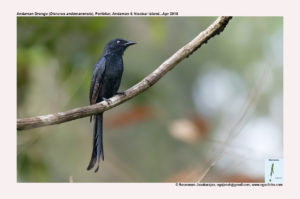Andaman Drongo

Andaman Drongo Dicrurus andamanensis
Etymology :
- Dicrurus : Greek word dikros – forked; ouros –tailed { Forked tailed}
- Andamanensis : From Andaman Islands in India
Distribution in India: Resident of Andaman & Nicobar Islands in India.
Description: Size of 28–29 cm. It is a distinctive glossy Drongo with deeply forked long tail, large black bill with sharply hooked upper mandible, at base of which a straight or back-curving tuft of thin hairy filaments. The feathers on each side of neck are slightly elongated. The male of nominate race is black, except for brownish primaries, and velvety black abdomen, flanks and undertail-coverts. The whole plumage is glossed with green, but gloss on lower throat and upper breast are more limited to end of feathers. The wing-linings are silvery brown, paler than upperwing, axillaries and underwing-coverts are tipped white. The tail is long (153–167 mm), and deeply forked (47–58 mm). The outer pair is pointed and strongly curved upwards, four inner rectrices becoming progressively shorter towards central pair. The iris is deep brown or blackish; bill and legs are black. The female is similar to male, but a little smaller, with less deeply forked tail. The juvenile is browner and less glossed than adult, lacking frontal filament, has more white tips on axillaries and underwing-coverts, tail initially more square-ended. Race dicruriformis is similar to nominate but much larger, tail is 150–182 mm, depth of fork is 62–70 mm.
Habitat: It is found in evergreen and broadleaf tropical moist lowland forests and edges; open forest and scrub-jungle.
Food habits: It eats winged insects, including ants. The prey is caught mostly by aerial hawking. It frequently perches head upwards on vertical trunk, in manner of a woodpecker, pressing tail against bark and ascending in flitting hops to take ants. It is gregarious, often forages with other species, like Asian Fairy-bluebird, White-headed Starling, Bar-bellied Cuckoo-shrike, Small Minivet. It often follows groups of primates and catching large insects disturbed by them.
Breeding habits: They breed in Apr to May in Andaman & Nicobar Islands. The nest is a shallow cup or cradle composed of fine dry twigs firmly woven together, scantily lined with black hair-like rhizomorphs, bound to the support by spider webs; suspended above ground from forked twig of very large forest tree, a dry or leafless one, or small tree standing in open forest or scrub-jungle. They lay a clutch of 2 -3 eggs.